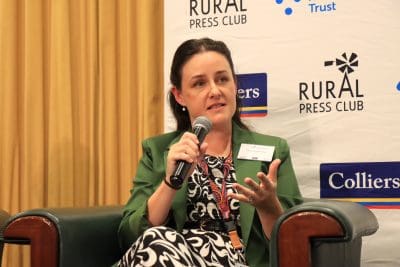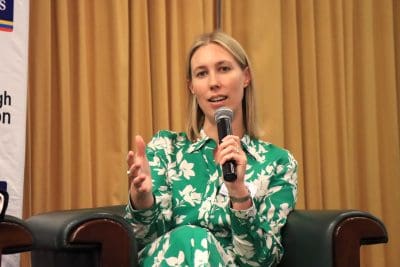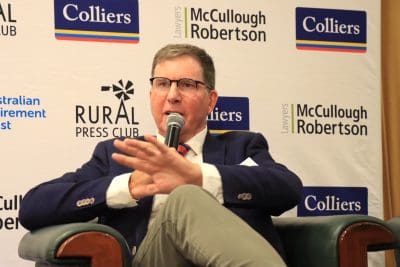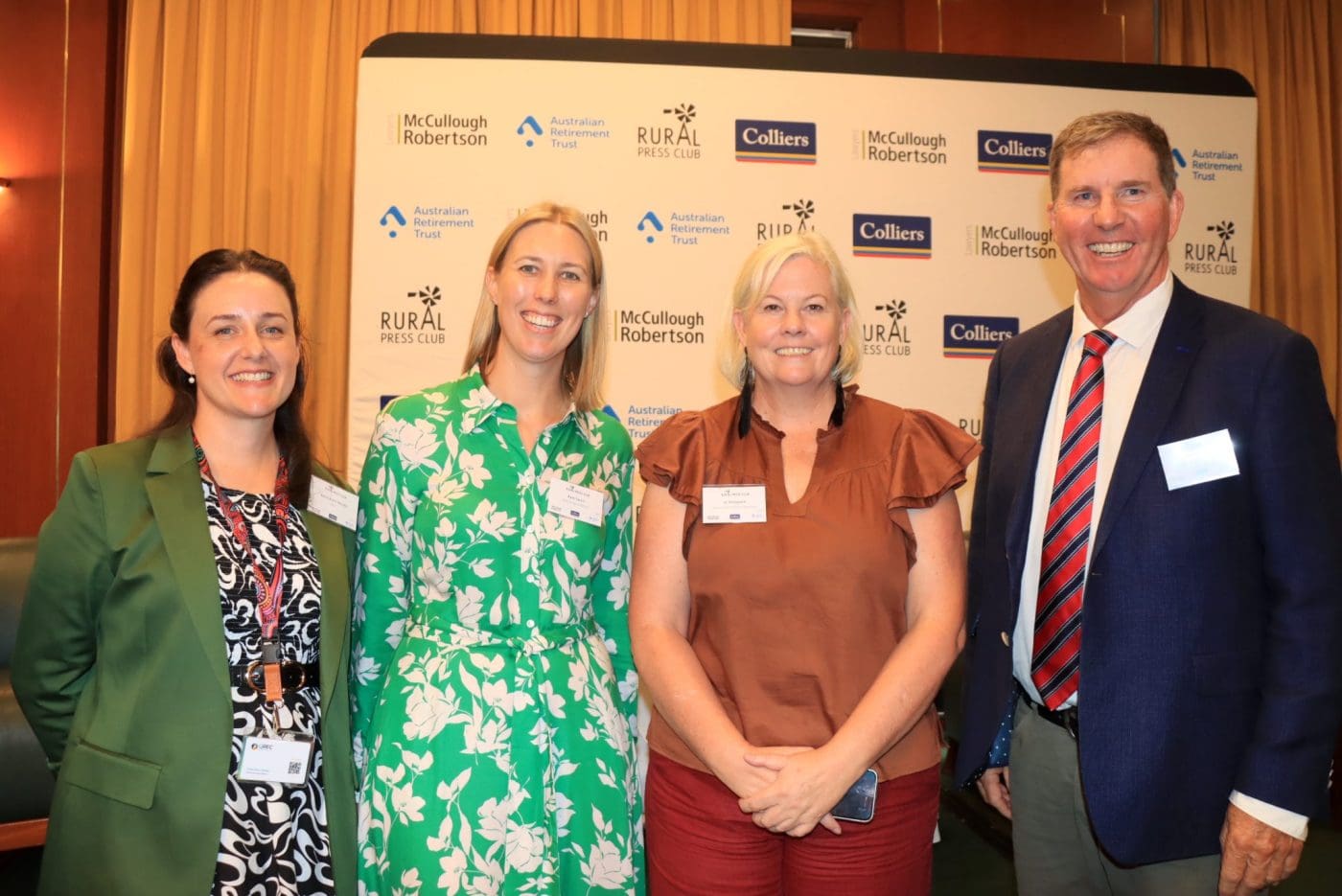
Rural Press Club of Queensland panelists (left to right) Qld Renewable Energy Council CEO Katie-Anne Mulder; McCullough Robertson partner Kate Swain, Queensland Farmers Federation CEO Jo Sheppard (moderator) and former AgForce and National Farmers Federation president Brent Finlay.
THE windfalls and pitfalls that rural landholders can face when dealing with renewable energy projects were brought to light in vivid detail at a Rural Press Club of Queensland lunch in Brisbane last Thursday.
The event provided a stark illustration of the vast scale of development potentially coming to inland Australia in the next few years as State and Federal Governments scramble to meet highly-ambitious renewable energy targets.
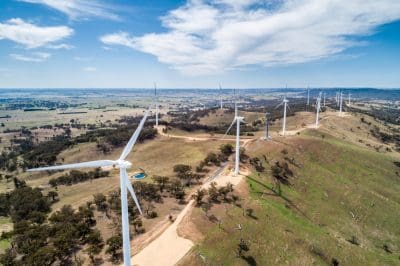 The Federal Government wants to increase the percentage of renewable energy powering the national grid from about 30 percent now to 82pc by 2030.
The Federal Government wants to increase the percentage of renewable energy powering the national grid from about 30 percent now to 82pc by 2030.
Some States have also set their own targets – Queensland is aiming for 80pc renewable power by 2035; Victoria 65pc by 2030; South Australia 100pc by 2030 and Tasmania 150pc by 2030.
NSW and WA have not yet committed to State-specific renewable energy targets.
The Rural Press Club of Queensland panel discussion was told that more than 2000 renewable energy projects are now in the pipeline for proposed development across eastern Australia.
To meet the Federal Government’s renewables target, Australia will need to build at least 40 new seven-megawatt wind turbines every month, and 22,000 five hundred-watt solar panels every day until 2030, Federal Energy Minister Chris Bowen revealed 18 months ago.
It will also need an estimated 28,000km of transmission lines to connect them to electricity grids.
Federal Treasurer Jim Chalmers acknowledged late last year that Australia is well behind on meeting its renewables targets, triggering a commitment to significantly expand a taxpayer-funded scheme to subsidise and underwrite new renewable energy projects to derisk investments for developers.
The renewables rush now underway has resulted in single landholders being approached by as many as seven or eight prospective developers trying to secure their land, the Rural Press Club of Queensland lunch was told.
“I think we can get there, absolutely”
In response to a question from Queensland Farmers Federation CEO and discussion moderator Jo Sheppard as to whether the Federal Government’s lofty renewable targets could be met, Queensland Renewables Energy Council CEO Katie-Anne Mulder agreed they were ambitious but achievable.
“I think we can get there, absolutely,” she said.
“Queensland is an incredible State in that we have done it before with CSG (coal seam gas) and LNG (liqueified natural gas) in a relatively short time frame.
“That was also a decade. This time our target is a little longer than a decade.
“I think we can certainly take lessons from previous industries that have done it before on what this actually means on the ground.
“And we are working through that with the industry, how should renewables be rolled out not just in a development space but also operationally long-term what does that look like?
“Because we know that Queensland is a pretty big State.
“So the answer for say for Chinchilla, Tara or Roma will be very different to what it looks like west of Mackay and west of Townsville around Hughenden and Flinders Shire.”
Can a farmer say no? And will that remain the case?
In Queensland, where the panel session was held, landholders have the opportunity to say no if approached by a wind or solar developer, McCullough Robertson partner and environment and planning lawyer Kate Swain said.
Legislative status can vary from State to State, but as a general guide, that contrasts with the legislative regime in place for the resources or gas sector in all Australian States and Territories, which provides operators with other pathways to gain access to a property if a landowner says no.
Is there a chance Governments may seek to change legislation in future and remove the landholders’ right to say no to renewable projects, in order to help meet their ambitious climate targets?
“There is always a risk or a possibility that Governments will legislate in the future for a permitting tenure type system like an exploration license or a mining lease down the track to ensure there is a system around getting access to that land for renewable projects,” Ms Swain said in response.
Pros to a permitting tenure system included reducing the number of developers landholders would deal with from several to back to one, while cons included overcomplicating the system and adding prescriptive rules.
‘Don’t shut the gate in the first instance’
Ms Swain, who has represented both landholders and developers in renewable energy projects previously, urged landholders in the initial stages to “be open to the conversation”.
“Don’t shut the gate to start to start with, invite them in,” she said.
“Listen to the renewable energy developer, take them for a drive around your property, understand what the opportunity is for you and understand what they’re wanting to do on the land.
“You’ve always got the opportunity to say no later.
“It is a commercial negotiation at the end of the day.
“But you don’t know what opportunity you may be missing out on, for instance a passive income in times when there is drought.”
She said if landholders say no, they could still face impacts they are opposed to if their neighbours say yes.
“You can’t do much about that. There are objection processes under planning approval systems, but at the end of the day that wind farm may be built next door.”
Vast scale
Former AgForce and National Farmers Federal president Brent Finlay currently has wind turbines being constructed on his wool growing farm in the Traprock region of South East Queensland.
He is one of nine landholders involved in the project being built by Acciona, which will be one of the largest wind farms in the Southern Hemisphere.
The scale is already vast. At different times his property has had hundreds of workers and as many as 100 pieces of yellow machinery working away.
He added that he can already see 100 wind turbines from his verandah now, and, if another planned project nearby goes ahead, that could soon rise to more than 300.
‘We backed the opportunity to diversify’
Asked how he weighed up the “impositions and opportunities” when deciding whether to host a wind farm, he said he and his fellow eight landholders involved in the project ultimately “backed the opportunity to diversify”.
“Renewables created that opportunity in our region for diversification, not every region has that opportunity,” he said.
“But again it is up to the landholders if they partake or don’t partake.”
‘You can’t do this on your own – Engage legal specialists’
His primary advice to other landholders when first dealing with renewable development proponents is to engage a legal team with extensive experience working with renewable energy projects.
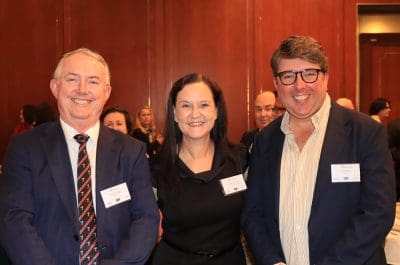
Catching up at the Rural Press Club Renewable Energy lunch were Rawdon Briggs, Colliers Agribusiness nd Rural Press Club Committee Members Carolyn Martin and Will Banks.
“That is so important because this industry is different again to the gas industry – different terminology, a different approach, there’s not a tenure based approach. You need to get as much information (about the project) as you can.”
Mr Finlay said he has visited 17 wind farms in Australia and New Zealand and urged other landholders considering hosting developments to go and see existing wind farms for themselves.
“It is so important to get an understanding of what that industry is and how it operates.
“It is not just the turbines, it is all of the infrastructure that comes in with that.”
Mr Finlay said the landholders in his project spent nine months with a team of laywers from McCullough Robertson on their behalf negotiating with the developer Acciona, and said negotiations and fine-tuning effectively “continued every day”.
“The comment that I’d make for landholders, and I know a lot of very smart landholders and corporate landholders – you can’t do this on your own.
“You need a team to help you and you need a team that really knows this industry, and they really need to know what the actual footprint is going to look like on your farm, because they’re all different.”
Farm work difficult during construction phase
He added that he has tried to keep operating his property as a commercial farming business during the wind turbine construction phase, which he said has proven to be “really difficult”.
“All of my neighbours decided no, we’re just going to let that commercial farm go, on those eight other properties until this project is finished.
“Managing that every day has been exhaustive and if I was to do the whole thing again, I probably would do what my neighbours did.”
Landholder renewable energy toolkit
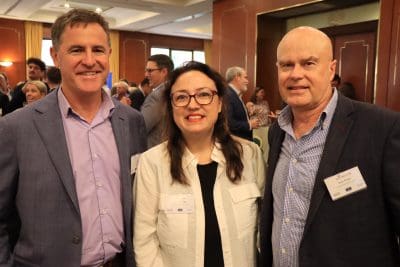
Richard Heath, CEO of Zero Net Emissions from Agriculture CRC, with Claire Chandler from Australian Retirement Trust and Mark Phelps from the Rural Press Club of Qld committee.
Moderator Jo Sheppard, the CEO of Queensland Farmers Federation, was heavily involved in the development of the QFF’s Landholder Renewable Energy Toolkit, which provides a comprehensive checklist of things landholders need to be aware of when first negotiating with developers (to download a free PDF version click here).
Like the Coal Seam Gas rush in inland Queensland a decade ago, regulations were not keeping pace with development, leading to calls from landholders for mandatory codes of conduct and compensation frameworks.
Satisfaction with developers low
Last month the Dyer Review for the Federal Government reported that 92 percent of respondents to a survey of regional experiences with renewable energy projects were unhappy with the way renewable energy developers had been dealing with landholders and regions overall.
Queensland Renewable Energy Council CEO Katie-Anne Mulder agreed that the results “were not great” and reflected a “variation of sophistication” among developers.
But she added that “a maturation” of the industry was occurring, as had happened with CSG.
“You’ll see the lower-end of the sector drop off, and the reason for that is when you get clear expectations from government and from the community about what is expected from the industry,” she said.
Now that the industry has scope and scale, she said, it was time to standardise and set clear expectations to make the process “predictable and transparent”.
“Transparency and predictability is what industry is after but it’s also what landholders are after as well.”
Concerns with non-disclosure agreements
Jo Sheppard said feedback QFF received from landholders during the development of the Renewable Energy Toolkit covered many issues including concerns around the fairness of non-disclosure agreements being included in contracts, which prevents farmers from knowing what other farmers in the same project are receiving.
Other considerations included how landholders are taxed on revenue from wind or solar farms, how carbon projects already underway on the same area of land may be impacted, and how renewable energy developments affected succession planning and mortgages.
Kate Swain said “it all can work”, but requires communication and was also “very much about understanding what the project is”.
“So it’s about taking that time to pull out the plans and look at the plans, understand the plan, get out in the field, go and look at other wind turbines.
“There’s a lot of the practical issues to understand and to then document into the contract, because no one project is the same as the next, so what you might need on your land, for the next landowner it isn’t relevant for their land.”
Decommissioning – who pays?
Discussion also turned to the key issue of who bears responsibility and cost for decommissioning large pieces of infrastructure at the end of project in 20 or 30 years time.
“What happens if there is a change down the track, a change of ownership etc, how do I make sure I’m not stuck with this enormous piece of infrastructure that I am then responsible for?,” Jo Sheppard asked.
Queensland Renewable Energy Council CEO Katie-Anne Mulder said decommissioning was the first or second issue raised by members of the community or Government.
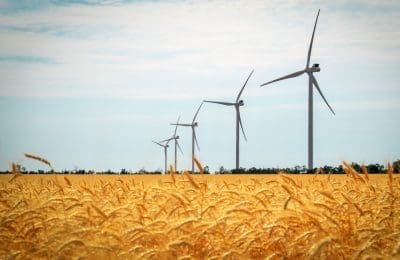 “This is one of these things where it is based per project, it is usually an agreement with the landholder or the local government area around the bond that is held, so there is that protection there,” she said.
“This is one of these things where it is based per project, it is usually an agreement with the landholder or the local government area around the bond that is held, so there is that protection there,” she said.
“What we would like to see is that it be brought up to an industry level, so rather than be dealt with on a project by project basis as I mentioned before there are standards across the industry, there is predictability so it doesn’t matter which region you go to, doesn’t matter which landholder you’re speaking to, there is a minimum standard of how decommissioning, how that process will endure work.
“So that’s one of the things we’re particularly looking to work with our membership on.
“We are only a couple of months old as a new industry body, but it’s certainly something that we’re looking to work with our members proactively on.
“… We need to ensure that our landholders are comfortable and are confident in the processes, the frameworks that are in place, so that they say yes to renewable energy developments and they can see the benefits.”
Government must step up
Brent Finlay said the Government had to “step up” and sort out the decommissioning issue.
“When I was at AgForce the disused mines or unused mines or abandoned mines across Queensland, there are thousands and thousands of them.
“If you look at the size and scope of what this industry is probably going to be, whether it is solar or if it is going to be wind, and what happens in 20, 30, 40 or 50 years’ time, basically we are doing it all over again.
“So Government, you may take all the benefits from what is going on with this industry now, but you need to actually step into some of these place and give some sort of assurance … to the landholders and communities that they’re not going to be left with a legacy issue here that no one will pay for.
“And that is one of the biggest things that could stop this industry going forward at the speed that others want it to.”

